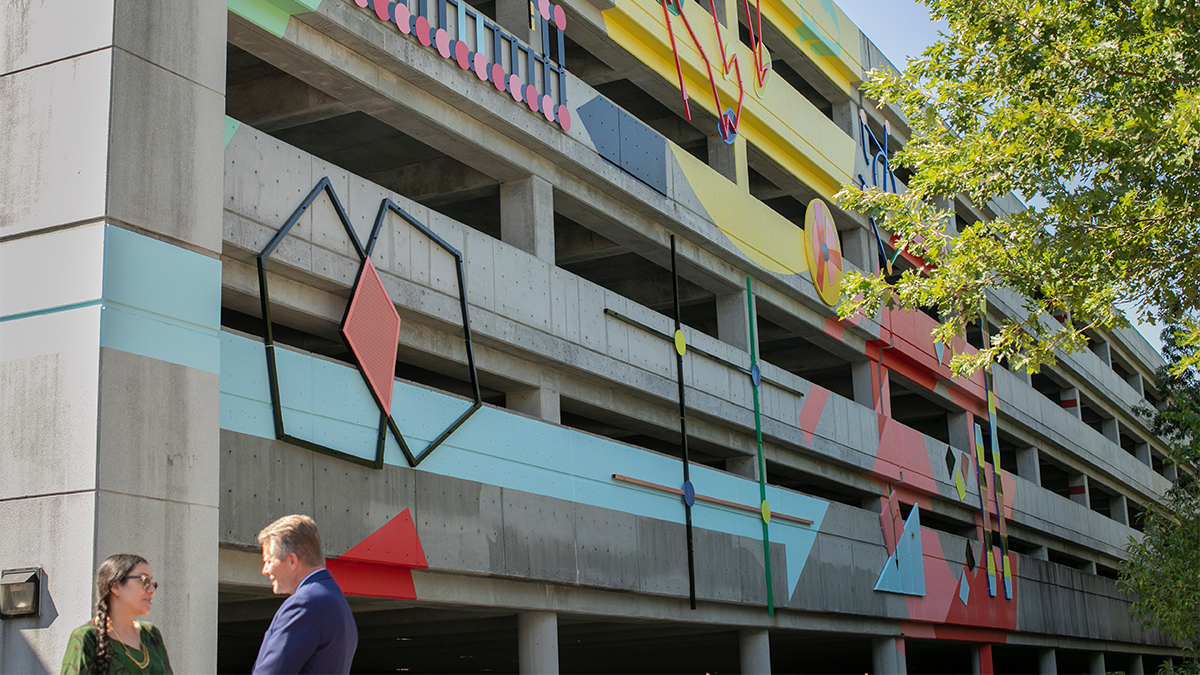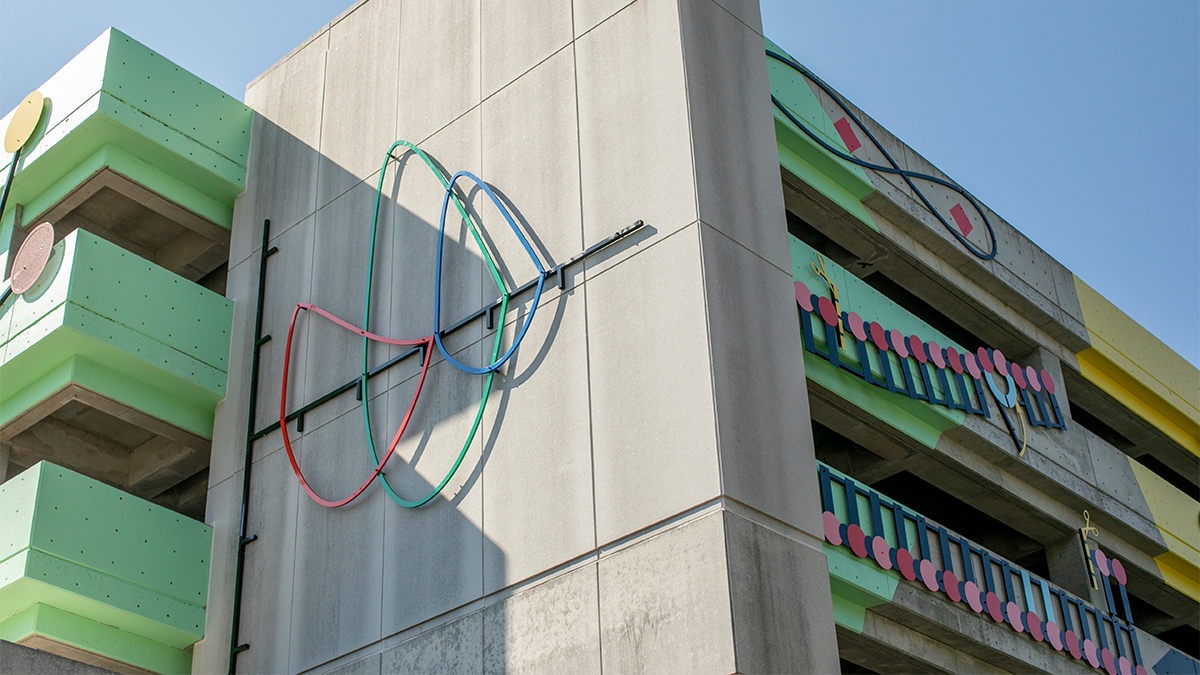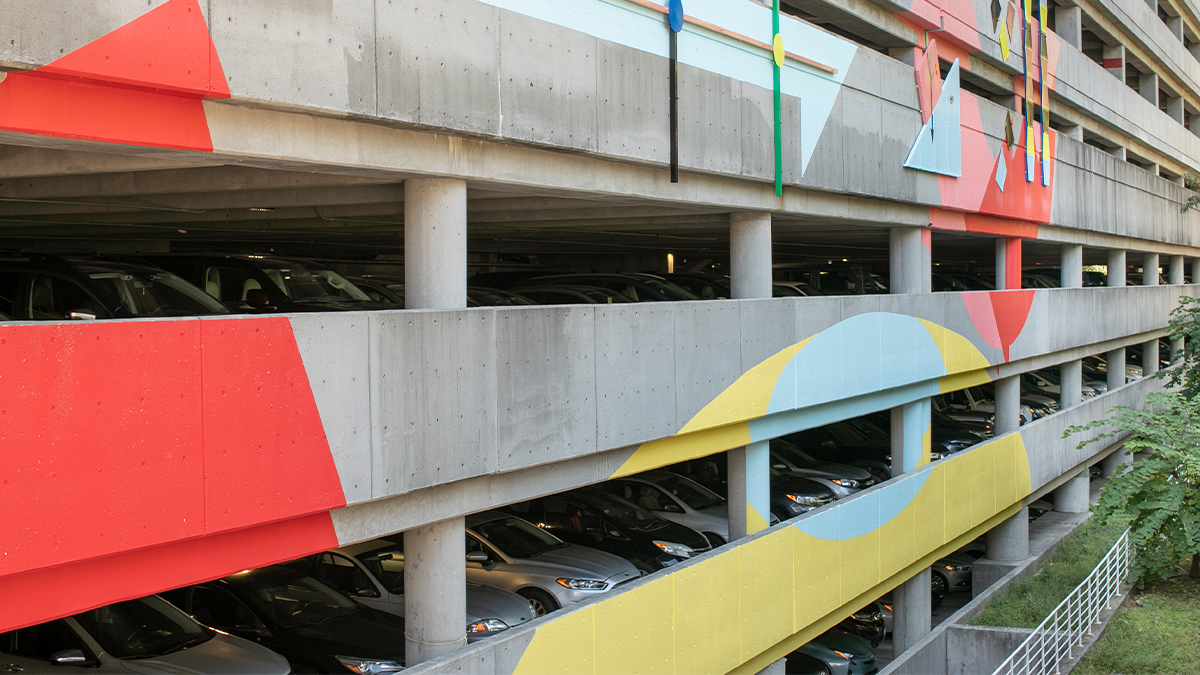‘Drawn to Explain’ debuts on Craige Deck
The installation by international artist Amalia Pica features diagrams used by Tar Heels, including a Nobel Prize winner and a legendary coach.

“Drawn to Explain” is international artist Amalia Pica’s tribute to the teaching on Carolina’s campus. The colorful designs splashed across the sides of Craige Parking Deck work on many levels. Yes, they decorate a drab gray façade with bright hues and simple shapes. But they also illustrate several complex concepts from science, medicine, physics, dance and even a certain basketball offense.
Inspired by “speed dating” meetings she had with about 50 faculty, staff and students in 2019, Pica used 14 of the diagrams they shared in her design. The large-scale mixed media installation of paint and powder-coated aluminum on concrete is now part of the permanent collection of the Ackland Art Museum.
Five years after Pica began work on the project, a Sept. 20 event at Craige Deck celebrated its installation, complete with cookies decorated with images from the artwork.
“‘Drawn to Explain’ by renowned artist Amalia Pica is a beautiful and deeply moving exploration of the sense of discovery that we have here at Carolina,” said Chancellor Kevin M. Guskiewicz in opening the ceremony. “It’s the perfect example of Arts Everywhere and its mission to make the arts accessible for all.”

(Jeyhoun Allebaugh/UNC-Chapel Hill)
Explorations of communication
An Argentinian native now based in London, Pica is a contemporary artist whose work often explores communication in a playful, engaging way. In “Eavesdropping,” for example, several colorful glasses are glued to a white wall, as if waiting for visitors to use them to listen in on a conversation.
In “Drawn to Explain,” Pica wanted to explore the role of images in learning, she said in a Sept. 21 talk at the Ackland. “Like many artists my age, I inherited this question about what the relation between art and language is and the role that understanding plays when we look at an image. This is something that sometimes makes contemporary art feel inaccessible to people. They feel they don’t understand. That question about whether there is something to understand is something that has been with me since the beginning.”
To help with understanding the art, the Ackland staff created an informational website about “Drawn to Explain.”
“You can’t just build it and they will get it,” Alison Friedman, director of Arts Everywhere and executive and artistic director of Carolina Performing Arts, told guests gathered at the parking deck. “Just as Amalia translated so many disciplines into the languages of her soaring public sculpture, so too is UNC’s own Ackland Art Museum translating and interpreting this work through online and on-site materials into languages for students, neighbors, the casual passersby, sport enthusiasts, so that this work truly belongs to everyone.”

(Jeyhoun Allebaugh/UNC-Chapel Hill)
Images that became part of Pica’s sculpture include illustrations of how cells can repair damage to DNA from 2015 Nobel Prize in Chemistry honoree Aziz Sancar, the four corners offense used by longtime men’s basketball coach Dean Smith and the social work licensure process.
The social work image came from a PowerPoint slide used by Kim Strom, Smith P. Theimann Distinguished Professor at the School of Social Work. “I use it to show how licensing and regulation is done throughout different jurisdictions — that wherever it is, it consists of exams, education and experience,” she said.
Now the diagram — a light blue arrow branching into three smaller red arrows — occupies a prominent corner of the façade. Strom was riding the bus down Manning Drive the other day when she first caught sight of it. “I felt like I discovered it anew,” she said.
“Drawn to Explain” was commissioned by Arts Everywhere with the support of the Office of the Chancellor, Transportation and Parking, the Carol L. Folt Fund for the Arts, Mr. and Mrs. Richard Lockwood Jr., James Keith Brown ’84 and Eric Diefenbach, Ackland Fund and John A. Powell ’77.







